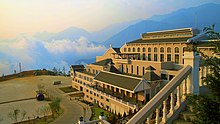Fansipan
This articleneeds additional citations forverification.(February 2024) |
| Fansipan | |
|---|---|
| Phan Xi Păng | |
 Monument at the summit of Fansipan | |
| Highest point | |
| Elevation | 3,147.3 m (10,326 ft)[1] |
| Prominence | 1,613 m (5,292 ft)[2] |
| Listing | Country high point Ultra |
| Coordinates | 22°18′12″N103°46′30″E/ 22.30333°N 103.77500°E[2] |
| Geography | |
Lào Cai Province,Vietnam | |
| Country | Vietnam |
| Region | Lai Châu,Lào Cai |
| District | Tam Đường,Sa Pa |
| Climbing | |
| Easiest route | Cable car |
Fansipan(Vietnamese:Phan Xi Păng,) is a mountain inVietnam.Its height was 3,143 metres (10,312 ft) in 1909, and it presently stands at 3,147.3 metres (10,326 ft).[1]It is the highest mountain on theIndochinese peninsula(comprising Vietnam,Laos,andCambodia), hence its nickname, "the Roof of Indochina". It is located in theLào Cai provinceof the Northwest region of Vietnam,nine kilometres (5+1⁄2miles) southwest ofSa Pa,in the Hoang Lien Son mountain range. Administratively, it is shared betweenTam Đường District, Lai ChâuandSa Patown.
Etymology
[edit]The origin of the namePhan Xi Păngis unclear. The most commonly accepted theory is that it evolved fromHủa Xi Pan( "the tottering giant rock" )—the name that the locals called the mountain, based on its shape. Another theory suggests that the name came from theHmong people,as it means "azalea mountain" intheir language,due to the prevalence ofazaleasand other species of theRhododendrongenus on the mountain.[3]
It has also been suggested that the name could have derived fromPhan Văn Sơn,a geography official in theNguyễn dynastywho helped the French map the area and define the border with China in 1905. Due to the inaccurate local pronunciation, the name generally evolved intoPhan Xi Păng.[3]
Geography
[edit]Fansipan is the tallest mountain in the Hoang Lien Son range, situated on the border ofLào CaiandLai Châu provinces,with its peak located on the Lào Cai side. The mountain is part ofHoàng Liên National Park.It has atopographic prominenceof 1,613 metres (5,292 ft), ranking sixth in Vietnam.[2]
Geology
[edit]Fansipan was formed around 250–260 million years ago, between thePermianperiod in thePaleozoicera and theTriassicperiod in theMesozoic.[4]TheHimalayan orogenysince Late Mesozoic has further uplifted Fansipan and the Hoang Lien Son range and created theRed River Faultto the east.[5]
Summit mark
[edit]The initial metal pyramid was made and installed on the mountain's peak by Soviet engineers fromHòa Bình province,in 1985. The amateur mountaineering expedition was the first since the end of thecolonial periodand was officially timed to the 40th anniversary ofVictory Dayof the Soviet Union over Nazi Germany.
Climbing
[edit]Hiking
[edit]Fansipan can be climbed in a steep and fairly strenuous hike. Previously, it took about 5–6 days fromSa Pato reach the peak and return. Now, the total time is usually only about three days, even two, or for experts and strong, healthy people, it can be done in one day.[clarification needed][citation needed]
Tour companies in the area will arrange hikes to the summit that take one to three days. Most recommend taking the two- or three-day options, and few guides will take tourists on a round trip in a single day.[6]
A very small village is located at around 1,500 m (4,920 ft), where accommodation and food is offered. Further up, at 2,800 m (9,190 ft), is an overnight camp. Most booked trips include the use of these facilities in their price, should they be required.[citation needed]
Cable car
[edit]

A cable car to the peak of Fansipan was inaugurated on 2 February 2016.[7]Thegondola liftdeparts from a terminal inMuong Hoa valley,near Sa Pa, and takes twenty minutes to reach the summit. The service holds twoGuinness World Recordsfor the longest nonstop, three-rope cable car in the world, spanning6.3 km (3+15⁄16mi), and the greatest elevation difference by a nonstop, three-roped cable car for the 1,410 m (4,626 ft) difference in elevation between the termini.[8] Currently, there are also climbing trains that help climbers get past the walking stairs.[9]
See also
[edit]- List of Southeast Asian mountains
- List of ultras of Southeast Asia
- List of elevation extremes by country
References
[edit]- ^abVNA (26 June 2019)."Fansipan peak found to be 4m higher than old measurement".VietnamPlus.Retrieved23 April2024.
- ^abc"Southeast Asia Mountain Ultra-Prominence".peaklist.org.22 February 2006.Retrieved23 April2024.
- ^ab""Phanxipăng" thực chất là... "Phan Văn Sơn"? ".Giadinh.net(in Vietnamese).Retrieved19 May2018.
- ^"Đỉnh Fansipan".Trung tâm Giáo dục Môi trường & Dịch vụ Môi trường Hoàng Liên(in Vietnamese).Hoang Lien National Park.Archived fromthe originalon 28 December 2021.Retrieved20 May2018.
- ^"Đá đỉnh Fansipan" chợt già thêm "vài trăm triệu tuổi"(in Vietnamese). Vietnam Union of Geological Sciences.Retrieved20 May2018.
- ^"Fan Si Pan, Vietnam",Peakbagger
- ^"Guinness cable car begins service to Fansipan".Viet Nam News. 7 February 2006.
- ^Swatman, Rachel."Longest non-stop three-rope cable car in the world opens in Vietnam".Guinness World Records.Retrieved20 May2018.
- ^"Fansipan Legend Sunworld Ticket Website".

